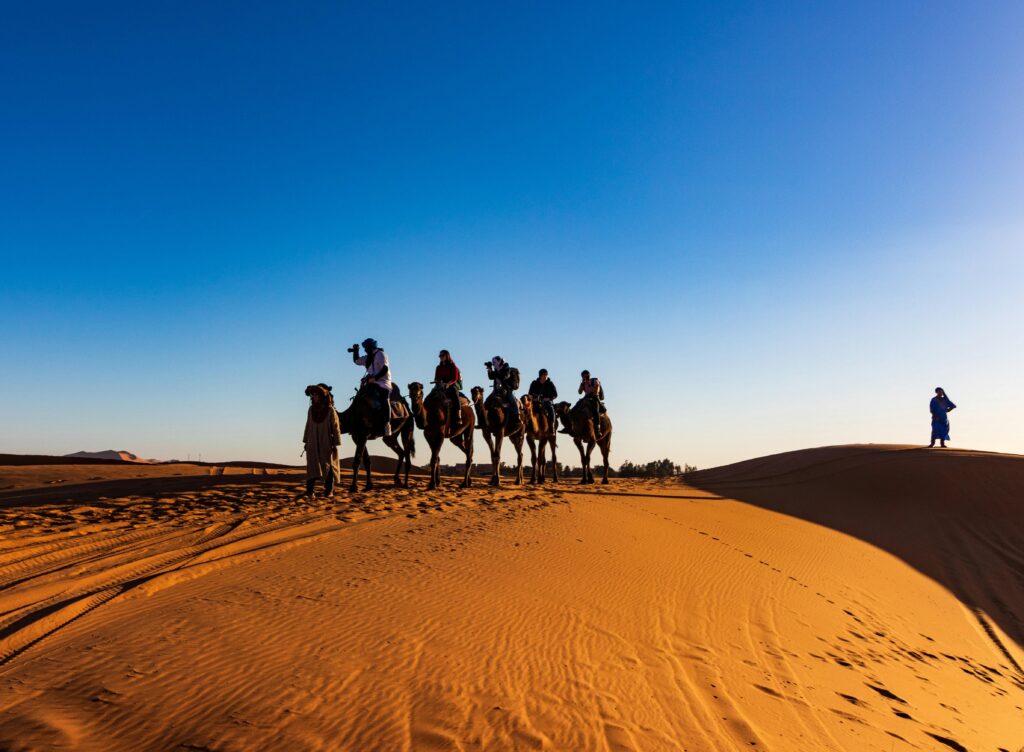
Morocco is a land of vibrant colors, rich history, diverse landscapes, and warm hospitality. From the golden dunes of the Sahara Desert to the bustling souks of Marrakech, Morocco offers a unique travel experience that appeals to every kind of traveler. But before you pack your bags, one crucial question remains: When is the best time to visit Morocco?
The answer depends on what you want to see, do, and experience. In this comprehensive guide, we’ll explore the weather patterns, major festivals, and the pros and cons of traveling during each season. Whether you’re interested in cultural experiences, outdoor adventures, or coastal relaxation, this article will help you plan the perfect Moroccan getaway.
And if you’re planning your first visit, be sure to check out our complementary article: 10 Things You Should Know Before Traveling to Morocco , it’s packed with essential travel tips and cultural insights that will enhance your journey.
Table of Contents
- Morocco’s Climate Zones
- Travel Seasons Overview
- Month-by-Month Guide
- Festivals & Cultural Events
- Checklist: What to Pack by Season
- Best Time to Visit by Travel Interests
1. Morocco’s Climate Zones
Morocco’s climate is incredibly diverse due to its varied geography. Here are the four main climate zones:
| Climate Zone | Regions Covered | Characteristics |
|---|---|---|
| Mediterranean | Northern coast, Tangier, Tetouan | Mild, wet winters and hot, dry summers |
| Continental | Fès, Meknès, and interior plains | Cold winters, hot summers |
| Mountain | Atlas Mountains | Snow in winter, cool summers |
| Desert | Merzouga, Zagora, Sahara region | Extremely hot in summer, cold in winter nights |
Understanding these zones helps you tailor your visit depending on the region and time of year.
2. Travel Seasons Overview
☀️ High Season (March to May & September to November)
- Weather: Pleasant, warm days and cool nights
- Highlights: Ideal for trekking, sightseeing, and desert tours
- Drawbacks: Crowded tourist spots, higher prices
❄️ Low Season (June to August)
- Weather: Very hot, especially inland and in the desert
- Highlights: Coastal towns are enjoyable; fewer crowds
- Drawbacks: Desert and city sightseeing can be unbearable due to heat
☔️ Shoulder Season (December to February)
- Weather: Cold in mountains and desert at night; mild on the coast
- Highlights: Good for cultural tourism and city exploration
- Drawbacks: Limited mountain hiking, snow in high passes
3. Month-by-Month Guide
| Month | Weather Summary | Travel Highlights |
| January | Cold in mountains/desert | Great for city visits and winter landscapes |
| February | Start of almond blossom | Quieter time, good for photography |
| March | Warmer days, cool nights | Beginning of high season |
| April | Ideal weather | Great for trekking and festivals |
| May | Peak spring beauty | Perfect for all activities |
| June | Hot inland, warm on coast | Visit Essaouira, Agadir |
| July | Very hot in cities/desert | Best for beach vacations |
| August | Similar to July | Explore Atlas Mountains, coastal relaxation |
| September | Cooling down | Excellent for hiking and tours |
| October | Comfortable temperatures | Popular for desert trips |
| November | Start of winter | Fewer tourists, great for cultural travel |
| December | Cold in interior/mountains | Festive ambiance, good for medina explorations |
4. Festivals & Cultural Events
Experiencing a Moroccan festival adds color and authenticity to your trip. Here are some must-see events:
| Festival | Time of Year | Location | Description |
| Ramadan (dates vary) | Shifts yearly | Nationwide | Spiritual month, fasting, rich night culture |
| Eid al-Fitr | End of Ramadan | Nationwide | Celebration, family gatherings |
| Gnaoua World Music Festival | June | Essaouira | Music, dance, and cultural exchange |
| Rose Festival | May | El-Kelaa M’Gouna | Celebrates rose harvest with parades and markets |
| Marrakech International Film Festival | December | Marrakech | Global cinema event, red carpet moments |
5. Checklist: What to Pack by Season
☀️ Spring & Fall:
- Light jacket or sweater
- Breathable clothing
- Sunglasses, hat, sunscreen
- Comfortable walking shoes
❄️ Winter:
- Warm layers (especially in mountains/desert)
- Waterproof jacket (for north/coastal)
- Scarf and gloves for cold nights
🌞 Summer:
- Loose, lightweight clothes
- Refillable water bottle
- Swimsuit (for beaches/hotels)
- Sandals and sunblock
6. Best Time to Visit by Travel Interests
| Interest | Best Time to Visit |
| Cultural exploration | March to May, Sept to Nov |
| Desert adventures | October to April |
| Beach holidays | June to August |
| Hiking & trekking | April to June, Sept to Oct |
| Photography | Spring (March-May), Fall |
| Festivals | May (Roses), June (Music), Dec (Film) |
Final Thoughts
Morocco is truly a year-round destination, but your experience can vary greatly depending on when you go. For mild weather and rich cultural experiences, spring (March-May) and fall (September-November) are ideal. If you’re seeking solitude, winter offers fewer tourists and quiet medinas. And if you crave sun and sea, summer along the coast is perfect.
No matter when you choose to visit Morocco, you’ll be met with warm hospitality, unforgettable landscapes, and deep cultural richness. Just remember to plan according to your interests and pack accordingly!
A Final Word from the Heart:
Travel is not just about the places you go, but about the connections you make and the memories you carry home. When you visit Morocco, take time to slow down, greet people with a smile, and open your heart to the unexpected beauty of each moment. The magic of Morocco lies not only in its majestic landscapes but also in its people , kind, generous, and full of stories. Let yourself be changed by the journey.
An articles that might benefit you :
